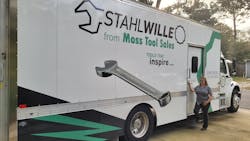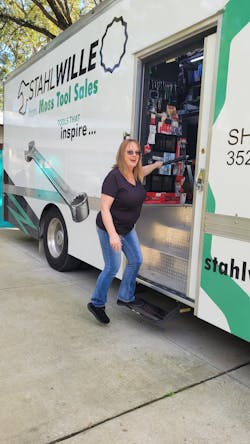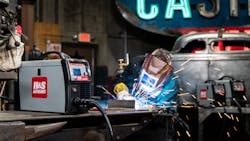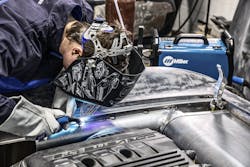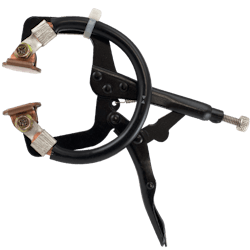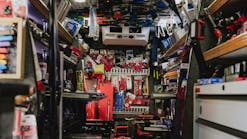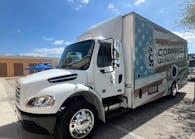When it comes to stocking welding and collision tools on your truck, it might seem like a daunting endeavor. As part of a vast and ever-changing industry, it’s important to understand what welding tools you should have on your truck and how to approach selling them to your customers. Just like with most things, the needs of one customer don’t always resemble the needs of the next and without proper knowledge it can be difficult to know where to start.
Making the sale
Independent distributor Shai Moss has found a way to sell welding and collision tools that works well for her business and benefits her customers. Moss started her business in 2019 after her husband suggested a change in occupation following a series of jobs that she was struggling to find enjoyment in. Hesitant at first, Moss did her share of research and hasn’t looked back since.
“I wish I had done it 20 years sooner,” says Moss.
Moss visits a broad variety of shops in her town of Gainesville, Florida. From dealerships and independently owned automotive shops, to the city bus garage and university motor pool. Any place she finds that looks like they’d be interested in buying tools, Moss finds time in her schedule to go and introduce herself.
Instead of keeping large, heavy equipment that might take up unnecessary room on her truck where other high-demand tools could be, Moss has found that keeping smaller products in stock works better for her. Things like hatch jammers, different types of clip lifters, flexi blocks, and other tools that her customers use regularly for welding and collision needs, have been some of her bestselling products. When it comes to selling actual welding machines, she orders them on a case-by-case basis. Understanding what a customer’s needs are is imperative to getting the proper products they’ll need to perform their repairs.
Getting the scoop on welding
Welding can be an advantageous skill to have in any auto body repair shop as vehicles evolve and move toward using more lightweight materials in their production. It can also be a dangerous process that should be done only by trained technicians in accordance with OEM repair guidelines.
“The biggest advantage of being able to weld and pull a dent rather than replace the entire panel is cost,” says Michael Cooper of H&S Autoshot. “Originally, if you had a dent, you had to replace the entire hood.”
For mobile tool distributors to carry proper tools and equipment that promote the safety of technicians, they must have a basic understanding of welding techniques and practices.
MIG vs. TIG
There are different welding techniques that technicians use to perform their jobs well. Most often, technicians will use MIG (metal inert gas) welding, a technique that joins metals together using a continuously fed wire electrode and shielding gas with a hand-held torch. For the technician who is just starting, MIG welding can be a good place to begin.
TIG (tungsten inert gas) welding is a process where a non-consumable tungsten electrode is used to produce a weld. This type of welding is less automatic than MIG welding and requires more precision in comparison. It is ideal for working on the small, delicate areas of a vehicle.
Miller electric offers the Multimatic 220 AC/DC, a multi-process welder that has both MIG and TIG functions. Users can switch welding gas, polarity, and welding process while recalling the last MIG or TIG settings. This option can be beneficial for a repair shop that doesn’t deal with collision repair as frequently, or for the technician who is looking to start welding.
Multi-process can be a beneficial feature, especially for first time welders, notes Beau Gellings, product manager of the Multimatic 220 at Miller Electric.
“Welding may not be the core competency of a [technician] or something that they do every day” says Gellings. “Therefore, they might be a little apprehensive to take on that task, especially if they’re not familiar with weld settings…that’s where the auto set from Miller is going to allow those technicians to get their projects set up quickly, efficiently, and accurately.”
Training for welders
The arrival of high-strength steel and aluminum in the production of many cars, has changed the way technicians approach repairs. Before, many repair shops would rely on a specialist to perform their welding needs. Now, most technicians can expect to encounter a welder at some point in their career.
Practice makes perfect in most industries, but this is especially true when it comes to welding. Brendan Geiger, welding engineer at Miller Electric, notes that training in the garage can often look like a technician grabbing some scrap metal and a welder and just seeing what they’re able to do with it. Experience varies from technician to technician, so having a selling approach that can be applied to a wide range of customers is beneficial.
Whether it’s spot welding—a process used, in many instances, to pull out dents on panels or replace them entirely—or more complex procedures that involve additional training and experience, any technician can excel in the world of welding with the proper training and tooling
Stocking your truck
When a technician is thinking about adding a welder to their repair shop, whether it’s the first welder or one of many, there are certain features that they look for. Depending on their experience level and comfortability, they’ll want to find something that fits the needs of their shops to a T.
Versatility
Miller Electric’s product manager, Robert Rodriquez, suggests looking for welders that offer versatility. This can look like a welder with the ability to switch between functions, like the Multimatic 220 from Miller Electric, or a welder that can be plugged into different amperages and voltages. For smaller repair shops that don’t have the space for more than one welder, versatility can broaden the scope of their work.
Size Matters
Dent Fix Equipment’s director of marketing, Geoff Preston recommends many tools for shops to keep in their toolbox but notes that smaller tools can be easier to keep on hand for mobile tool distributors.
Smaller tools like Dent Fix’s Shunting Pliers, No. DF-SP360, don’t take up much space on the truck making them easy to stock. The pliers help ensure proper welds with their thick copper wire and pads and are beneficial for squeeze-type resistance spot welding which sometimes requires additional measures, in the form of shunting the current flow to create a spot weld.
Portability
“[Technicians]may not want to have three different welders in their shop,” says Miller’s Rodriquez. “They may not have the space.”
That’s where portability comes into play. The Professional 200A MIG Welder, No. HSW-6220, from H&S Autoshot is a professional portable inverter MIG welder with 200A of power on a 230V line. Lighter and portable equipment allows users to move the welder around their shop instead of having a stationary setup that could limit the technician's abilities. With portability, the need for multiple welding stations is limited.
Sales Tips
As a mobile tool distributor, you might not sell welding and collision tools to your customers on a regular basis, but when the time does come, you’ll want to be prepared.
1. Ask Questions
Finding the right welder for your customer is all about understanding the individual needs of their shop. Ask questions about the scope of their work, the repairs they typically deal with, and the training their technicians have undergone or plan to take. Moss recommends asking specific, leading questions like what type of metal they’re using and how thick it is. What is the end goal and what do they have available that will help them reach that goal? Fill in the gaps in their answers by offering up a tool that will make their job more efficient.
2. Create a game plan
There’s a well-known saying, “if you fail to plan, you plan to fail.” When you fail to come up with a strategy to sell your welding tools, you might find it difficult to get products into the hands of your customers. Do your research on the ways your products can be used by your customers. This might look like going into shops and asking questions like Moss does with her customers.
“Conduct your research and create a game plan,” says Geoff Preston, director of marketing at Dent Fix Equipment. “Shops follow the equipment guidelines published from the vehicles [and] brands they wish to consider repairing. Many manufacturers have contacts that help shops align with the certification requirements and are a great information source.”
3. Find resources to stay up-to-date
Staying up-to-date on welding technology can be tricky, especially with new products and innovations coming out regularly. Moss likes to stay current on industry trends by looking at manufacturers' websites she’s purchased from in the past and reaching out to see if they would be willing to send her new information. She also recommends finding and subscribing to newsletters that cover welding and collision repair news.
As a distributor, working in the ever-changing automotive industry means there’s always something new for you to learn. If you’re thinking about adding welding equipment and tools to your truck’s inventory and you’re not sure where to start, don’t be afraid to reach out to manufacturers or skilled technicians in the industry. Chances are they’ll be happy to share their knowledge with you.
